
Benefits of Automation
DCF automated filtration systems are often used in lieu of
filter bag and cartridge systems to reduce operating costs.
The cost of replacement filter media and disposal of spent
media are pretty easy to calculate. Reduction of personnel's
interaction with the filtered liquid may reduce work related
injuries and frees-up those employees to do other tasks. The
aspects of liquid carry-out and process contamination are
also reduced. Carry-out refers to the process liquid lost
during the filter bag or cartridge change-out. During
change-outs there is increased risk for spillage and
contamination beyond the filter media. Many companies do not
fully appreciate costs associated with manually maintained
filtration systems!
Another advantage of a fully
automated system is maintaining a consistent downstream
pressure, eliminating the spikes in pressure characteristic
of manually maintained filtration systems; for some
applications steady pressure contributes product quality.
The DCF-Series was developed for non-water applications
for liquids that were especially challenging to filter due
to their viscosity, aggressiveness or viscoelastic
properties. An advantage of the DCF design is that it can
maintain a continuous low differential pressure while
minimizing product loss during its cleaning cycle. The DCF
design provides simple and reliable operation.
 How
Mechanically Cleaned Filters Work
How
Mechanically Cleaned Filters Work
Liquid flows
into the top of the filter station and down through the
center of the filter element, passing through the element
walls and exiting the outlet connection. The topside of the
element is sealed; thus, all of the unfiltered liquid enters
the filter element. Whatever particles are too large to pass
thorough the element end-up falling to the bottom of the
vessel or become stuck against the inner circumference of
the element wall.
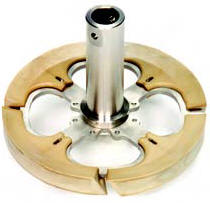
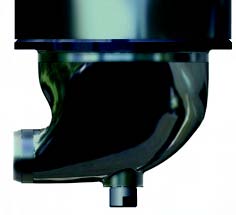 A
spring-loaded cleaning disc travels the length of the
element (the frequency of stroking is user programmable) and
this pushes any material stuck on the sides of the element
downwards to the bottom of the vessel, aptly referred to as
the "purge chamber". The quartered and spring-loaded
cleaning disc is designed to ensure even and consistent
force against the element to maximize cleaning efficiency
without damaging the 316SS element.
A
spring-loaded cleaning disc travels the length of the
element (the frequency of stroking is user programmable) and
this pushes any material stuck on the sides of the element
downwards to the bottom of the vessel, aptly referred to as
the "purge chamber". The quartered and spring-loaded
cleaning disc is designed to ensure even and consistent
force against the element to maximize cleaning efficiency
without damaging the 316SS element.
The specially
shaped purge chamber fills with a concentrate of solids and
is "flushed" based upon system pressure once the drain valve
is opened. The flushing force is the differential pressure
between the system pressure and atmospheric pressure. The
flushing frequency and duration are both user programmable
(and can be manual if desired), however the time required
for "flushing” is usually only a second or two.
The
model illustrated to the left has twin actuators, a design
typically reserved for higher viscosity liquids. Less
viscous liquids often only require a single actuator.
DCF filter systems for 20 to 1500+ GPM cost ≥$11,000 to
$65,000+ depending upon the filter station body size and
automation required. The cleaning strokes require compressed
air and the frequency is adjustable by controlling the air
flow. Purging the filter chamber can be controlled manually,
although typically done via a "push button" controlled air
actuated ball valve. The automation of this system can
include pneumatic or electric timers for both stroke and
purge frequency or even preprogrammed PLC that can network
with the customers control system.
|
Specifications: |
|
|
• |
30-300 PSI operating pressure. |
|
• |
Flow rates up to 1,500 GPM. |
|
• |
Operating temperatures up to 400°F |
|
• |
Maximum solids concentration: 200 PPM |
|
• |
Particle retention range: 15 to 6250 microns |
|
• |
All wetted components 316SS |
|
• |
Elastomers and plastics are Viton®/EPT, urethane, Teflon® and Delrin® |
|
Requires: |
|
|
• |
5 CFM of 80 PSI clean, dry, non-lubricated compressed air. |
|
• |
115-230v/1ph/50-60Hz electrical service. |
Various models of DCF automated
filter systems are available depending upon the flow rate of
the application or special characteristics of the liquid
involved. DCF-400, DCF-800 and DCF-1600 have progressively
larger filter bodies to accommodate higher flow rates (20,
60 and 200 GPM maximum respectfully). Flow rates in excess
of 1500 GPM are addressed by connecting multiple DCF filter
systems to a common inlet, outlet and purge manifold and
customized PLC.
Specialized DCF Automated
Filter Systems
The DCF-2000 was designed for the
pulp and paper industry and filtration of "white water". It
differs from the other DCF designs because it has an
electrically operated motor driven cleaning disc, enabling
it to handle up to 72% solids at super fine 75-micron
retention. The cleaning disc not only continuously sweeps
the element clean to maintain a low differential pressure,
but also agitates the purge chamber to keep the solids in a
semi-liquid state for efficient purging.
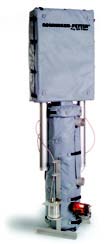 DCF-FRY
OIL, is designed with FDA approved materials and insulation
to filter hot fry oil (up to 400F), eliminating vibratory
filters and paper band filters.DCF-3000 has dual cleaning
disc assemblies and has a capacity of about 2½ times the
DCF-1600. Depending upon the viscosity, the DCF-3000 can
handle from 500 to 1,500 GPM.
DCF-FRY
OIL, is designed with FDA approved materials and insulation
to filter hot fry oil (up to 400F), eliminating vibratory
filters and paper band filters.DCF-3000 has dual cleaning
disc assemblies and has a capacity of about 2½ times the
DCF-1600. Depending upon the viscosity, the DCF-3000 can
handle from 500 to 1,500 GPM.
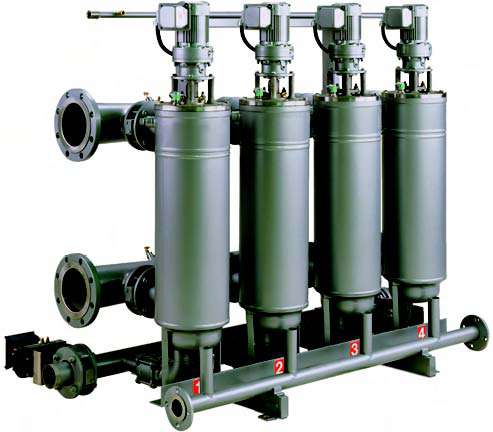 Multiplexed
DCF Filtration SystemsThe DCF-1600, DCF-2000 and DCF-3000
can be "multiplexed" for higher capacities. We can
essentially mount multiple filter stations to a common
inlet, outlet and drain manifold to enable us to provide a
higher open area filtration ratio and handle higher flow
rates.
Multiplexed
DCF Filtration SystemsThe DCF-1600, DCF-2000 and DCF-3000
can be "multiplexed" for higher capacities. We can
essentially mount multiple filter stations to a common
inlet, outlet and drain manifold to enable us to provide a
higher open area filtration ratio and handle higher flow
rates.
Magnetically Actuated Cleaning
The model DCF-824 uses powerful rare earth magnetics to
drive the cleaning disc up and down, eliminating the need
for conventional actuators having physical linkage and seals
passing through the vessel. Thus, the MCF-824 is typically
used for hazardous liquids and locations where there is not
enough room to fit an external actuator.
The
functionality of the MCF-824 is the same as the other DCF
automatic filter systems with the difference being there is
a hollow shaft at the center of the system containing a
magnet which is coupled to an external magnet attached to
the cleaning disc. Pneumatic actuation from standard shop
compressed air injected through the base of the center
column pushes the internal magnet up and down. The outer
magnet within the cleaning disc follows the internal magnet.
The MCF-824 is used for flow rates up to 200 GPM and
liquids within 30-150 PSIG @ ≤180F. Its particle retention
range is from 150 to 6250 m.The
DCF-Series was developed for non-water applications where
the fluids being filtered were especially challenging, perhaps
being viscous, abrasive, or sticky. The advantages of the DCF
design is that it will maintain a continuous low differential
pressure and minimize product loss during the cleaning cycle.
The DCF design provides simple, reliable operation in which a
low initial investment is a key driving factor.
Use the navigation bar or click within the chart below to learn more about DCF, MCF and MCS filters and strainers.
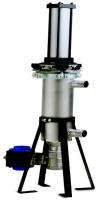 |
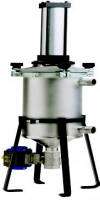 |
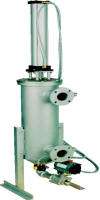 |
| DCF-400 | DCF-800 | DCF-1600 |
| ≤ 20 GPM | ≤ 60 GPM | ≤ 200 GPM |
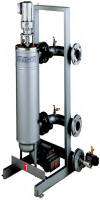 |
 |
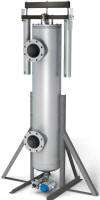 |
| DCF-2000 | MCF-824 | DCF-3000 |
| ≤ 200 GPM High Solids "white water" |
≤ 200 GPM Hazardous Fluids |
≤ 1500 GPM High Viscosity |
 |
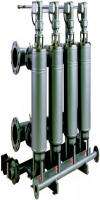 |
|
MCS-500 MCS-1500 |
MULTIPLEX |
| ≤ 1500 GPM | ≤ 12,000 GPM |
| FEATURES | BENEFITS |
| • Eliminate disposable filter media such | • Reduced disposal costs, material loss, labor, exposure and inventory |
| • Linear down and up cleaning motion | • Provides constant low differential pressure |
| • Uninterrupted product flow during cleaning | • Process consistency |
| • Compact footprint | • Retrofits to most existing pipelines |
| • For use with a wide range of contaminate types, including gels. | |